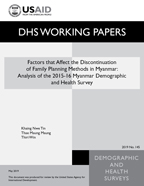- PUBLICATIONS
- JOURNAL ARTICLES
- ACCESS PUBLICATIONS
Publications Summary
- Document Type
- Working Papers
- Publication Topic(s)
- Family Planning, Fertility and Fertility Preferences
- Country(s)
- Myanmar
- Survey
- Myanmar DHS, 2015-16
- Language
- English
- Recommended Citation
- Nwe Tin, Khaing, Thae Maung Maung, and Thiri Win. 2019. Factors that Affect the Discontinuation of Family Planning Methods in Myanmar: Analysis of the 2015-16 Myanmar Demographic and Health Survey. DHS Working Paper No. 145. Rockville, Maryland, USA: ICF.
- Download Citation
- RIS format / Text format / Endnote format
- Publication Date
- May 2019
- Publication ID
- WP145
Download
 Factors that Affect the Discontinuation of Family Planning Methods in Myanmar: Analysis of the 2015-16 Myanmar Demographic and Health Survey (PDF, 733K)
Factors that Affect the Discontinuation of Family Planning Methods in Myanmar: Analysis of the 2015-16 Myanmar Demographic and Health Survey (PDF, 733K)
